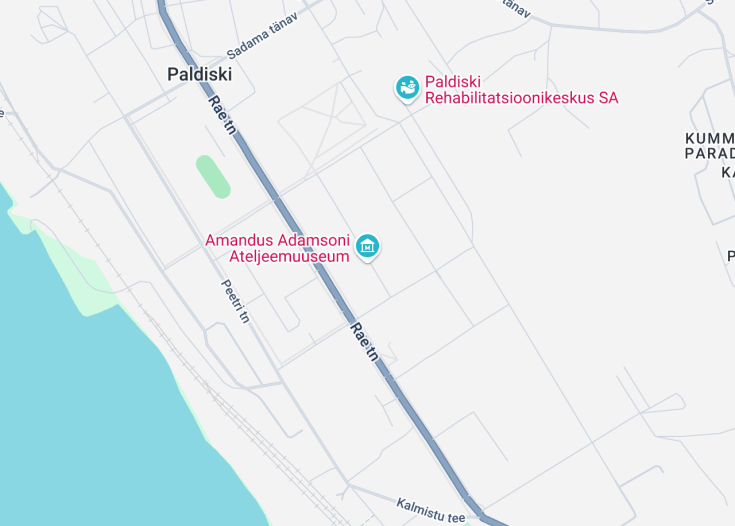Amandus Adamsoni Ateljeemuuseum: A Glimpse into Estonia’s Artistic Heritage
The Amandus Adamsoni Ateljeemuuseum in Paldiski, Estonia stands as a testament to the rich cultural tapestry of the region. Dedicated to the renowned Estonian sculptor and painter, Amandus Adamson, this museum offers visitors an immersive experience into his creative world. Nestled in the scenic coastal town of Paldiski, the museum not only showcases Adamson’s masterpieces but also provides insights into his artistic journey and the historical context of his works. For tourists, the Amandus Adamsoni Ateljeemuuseum is a must-visit destination that combines art, history, and the serene beauty of Estonia’s landscape. The museum’s thoughtfully curated exhibits highlight Adamson’s contributions to Estonian art, making it a focal point for both art enthusiasts and casual visitors alike. Additionally, the museum often hosts temporary exhibitions, workshops, and cultural events, further enriching the visitor experience and fostering a deeper appreciation for Estonia’s artistic legacy.
Explore the Artistic Treasures at Amandus Adamsoni Ateljeemuuseum
At the Amandus Adamsoni Ateljeemuuseum, visitors can immerse themselves in a diverse array of artistic expressions. The museum houses an extensive collection of Adamson’s sculptures and paintings, each piece reflecting his unique style and creative prowess. Guided tours are available, providing in-depth commentary on the significance of each artwork and the artist’s techniques. Additionally, the museum features interactive workshops where guests can engage in hands-on artistic activities, fostering a deeper connection with Adamson’s craft. For those interested in the architectural aspect, the building itself is a work of art, blending traditional Estonian design with modern elements. Don’t miss the serene garden area, perfect for a leisurely stroll while appreciating the outdoor installations and sculptures. Whether you’re an art connoisseur or a curious traveler, the Amandus Adamsoni Ateljeemuuseum offers a rich and engaging experience that caters to all interests.
Discover the Legacy of Amandus Adamson at the Ateljeemuuseum
An interesting fact about the Amandus Adamsoni Ateljeemuuseum is that it not only preserves Adamson’s original works but also serves as a creative hub for emerging Estonian artists. The museum regularly hosts collaborative projects and exhibitions that bridge the gap between past and present artistic endeavors. This dedication to nurturing new talent ensures that Adamson’s legacy continues to inspire future generations. Additionally, the museum’s location in Paldiski, a town with its own unique history, adds another layer of depth to the visitor experience. The intertwining of Adamson’s artistic journey with the local culture creates a dynamic and vibrant atmosphere, making the Amandus Adamsoni Ateljeemuuseum a cornerstone of Paldiski’s cultural scene.
Discover the Charm of Amandus Adamsoni Ateljeemuuseumin Paldiski, Estonia
Immerse yourself in the artistic legacy of Amandus Adamson at the Ateljeemuuseum in Paldiski, Estonia. This unique museum is a haven for art enthusiasts, history buffs, and cultural explorers alike. Visitors can expect an enriching experience that showcases Adamson’s intricate sculptures and diverse artworks, offering a glimpse into his creative genius. The museum seamlessly integrates into the broader tourist routes of Paldiski, making it an essential stop for those exploring the region’s rich cultural tapestry. Professional guides provide exclusive insights, sharing anecdotes and lesser-known facts that enhance the visit. Whether you’re planning a solo trip, a family outing, or a cultural tour with friends, the Amandus Adamsoni Ateljeemuuseum promises an unforgettable journey through art and history.
Optimal Seasons to Experience Amandus Adamsoni Ateljeemuuseum
The best time to visit the Amandus Adamsoni Ateljeemuuseum is during the late spring and early autumn months. During these periods, the weather in Paldiski is mild, providing a comfortable environment for exploring the museum and its surroundings. Additionally, visiting in these seasons allows you to enjoy fewer crowds, ensuring a more personalized and tranquil experience.
Annual Art Exhibition
If you’re keen on experiencing the museum at its most vibrant, plan your visit during the annual art exhibition held every September. This event showcases contemporary artists inspired by Adamson’s work, offering a dynamic blend of traditional and modern artistry.
Accessibility and Limitations
The Amandus Adamsoni Ateljeemuuseum is thoughtfully designed to accommodate a wide range of visitors, ensuring an inclusive experience for all.
Accessibility
The museum is fully accessible to individuals with mobility challenges, featuring ramps, elevators, and accessible restrooms to facilitate easy navigation throughout the premises.
Limitations
- Photography is restricted in certain exhibition areas to protect the integrity of the artworks.
- Large bags and backpacks are not permitted inside the galleries.
Notes to visitors
- Visitors are encouraged to book guided tours in advance to secure their preferred time slots.
- Audio guides are available in multiple languages to enhance the touring experience.
General Informations
Plan your visit to the Amandus Adamsoni Ateljeemuuseum with all the essential details to ensure a smooth and enjoyable experience.
Location
Nestled in the heart of Paldiski, the museum is conveniently situated near the bustling city center and the main bus terminal, making it easily accessible for travelers.
Address:
Vabaduse pst 12 – Paldiski, 01621
Visiting Information
The Amandus Adamsoni Ateljeemuuseum welcomes visitors throughout the week, offering flexible hours to accommodate different schedules. For the best experience, consider visiting in the morning when the galleries are less crowded, allowing for a more intimate interaction with the exhibits.
How to Reach the Museum
Getting to the Amandus Adamsoni Ateljeemuuseum is straightforward, with multiple transportation options available from Paldiski’s city center.
Car
The museum can be easily accessed by car. There is ample parking available in the nearby parking structure for a nominal fee, as well as several parking lots within walking distance.
| Route |
Distance |
Travel time |
| From Paldiski Bus Terminal |
1 mile (1.6 km) |
5 minutes |
| From Paldiski Ferry Port |
0.8 miles (1.3 km) |
4 minutes |
| From Paldiski City Hall |
0.5 miles (0.8 km) |
3 minutes |
Public Transport
Public buses run regularly from key points in Paldiski to the museum. The nearest bus stop is just a short walk from the museum’s entrance, ensuring convenient access without the hassle of parking.
| Route |
Distance |
Travel time |
| From Paldiski Central Station |
1 mile (1.6 km) |
10 minutes |
| From Paldiski Shopping Mall |
0.7 miles (1.1 km) |
7 minutes |
| From Paldiski University |
0.6 miles (1 km) |
6 minutes |
Nearby Attractions
- Paldiski Lighthouse – 0.5 miles (0.8 km)
- Paldiski Marina – 0.6 miles (1 km)
- Historical Naval Museum – 0.7 miles (1.1 km)
- Seaside Park – 0.8 miles (1.3 km)
- Paldiski Art Gallery – 0.9 miles (1.4 km)
- Old Fort Ruins – 1 mile (1.6 km)
- City Botanical Garden – 1.1 miles (1.8 km)
- Paldiski Market Square – 1.2 miles (1.9 km)
- Local Brewery Tour – 1.3 miles (2.1 km)
- Paldiski Concert Hall – 1.4 miles (2.3 km)
- Maritime Heritage Center – 1.5 miles (2.4 km)
- Paldiski Cinema – 1.6 miles (2.6 km)
Common Questions
What is the history of Amandus Adamsoni Ateljeemuuseum?
Amandus Adamsoni Ateljeemuuseum, located in Paldiski, Estonia, serves as a tribute to the renowned Estonian sculptor Amandus Adamson. Established to preserve and showcase Adamson’s artistic legacy, the museum was founded shortly after his death in the early 20th century. Originally, the atelier functions as both a museum and a workshop, allowing visitors to gain insight into Adamson’s creative process. Over the years, the museum has expanded its collection to include not only Adamson’s sculptures but also works from other Estonian artists who were influenced by his techniques and artistic vision. The museum plays a pivotal role in maintaining the cultural heritage of Estonia, offering a space where art, history, and education intersect.
What type of art is showcased at the Amandus Adamsoni Ateljeemuuseum?
The Amandus Adamsoni Ateljeemuuseum primarily showcases sculpture, reflecting Amandus Adamson’s specialization in this medium. The museum’s collection includes a diverse range of sculptures, from classical to more contemporary styles, highlighting the evolution of Estonian sculpture over the years. In addition to Adamson’s own works, the museum features pieces by other Estonian artists who have contributed significantly to the field. The exhibits often include: – Portrait Sculptures: Detailed representations of notable figures from Estonian history and culture. – Abstract Works: Modern sculptures that explore form, space, and materiality. – Historical Pieces: Artifacts and sculptures that provide insight into the artistic movements of different eras. Moreover, the museum occasionally hosts temporary exhibitions that focus on specific themes or artists, further enriching the visitor experience with a variety of artistic expressions.
Who was Amandus Adamson?
Amandus Adamson (1855-1929) was a prominent Estonian sculptor known for his significant contributions to the art of sculpture in Estonia. Born in Tartu, Adamson pursued his artistic education in Saint Petersburg, where he was influenced by the prevailing artistic trends of his time. Upon returning to Estonia, he became a pivotal figure in the development of Estonian national art, focusing on creating works that reflected the country’s cultural identity and heritage. His notable works include statues of key historical figures, public monuments, and commemorative sculptures. Adamson’s legacy is preserved through the Amandus Adamsoni Ateljeemuuseum, which not only displays his works but also serves as a center for artistic education and appreciation in Estonia.
What are some notable works in the museum's collection?
The Amandus Adamsoni Ateljeemuuseum houses several notable works that highlight both Adamson’s mastery and the broader scope of Estonian sculpture. Some of the key pieces include: 1. Monument of Jakob Hurt: A significant statue dedicated to the Estonian folklorist and writer, showcasing Adamson’s attention to detail and expression. 2. Portrait of Karl August Hermann: Reflecting Adamson’s skill in capturing the likeness and essence of prominent individuals. 3. War Memorials: Sculptures commemorating Estonian soldiers, demonstrating the intersection of art and national history. 4. Abstract Sculptures: Modern pieces that explore innovative forms and materials, representing the evolution of sculptural art in Estonia. 5. Public Monuments: Works installed in various locations around Estonia, emphasizing Adamson’s impact on public art. These pieces not only exhibit technical proficiency but also convey narratives that are deeply rooted in Estonia’s cultural and historical context, making the collection both artistically and historically significant.
Are there any workshops or artist studios at the museum?
Yes, the Amandus Adamsoni Ateljeemuuseum incorporates interactive spaces that serve as workshops and artist studios. These areas are designed to provide visitors with a hands-on experience, allowing them to engage directly with the artistic process. The museum offers: – Sculpting Workshops: Guided sessions where participants can learn basic sculpting techniques using various materials. – Artistic Demonstrations: Live demonstrations by resident artists, showcasing different methods and tools used in sculpture. – Studio Tours: Opportunities to explore the working spaces of contemporary artists, gaining insight into their creative environments. – Educational Programs: Structured programs aimed at different age groups, fostering artistic skills and appreciation. By integrating these interactive elements, the museum not only displays art but also actively contributes to the cultivation of new artistic talents and the continuation of traditional sculpting practices in Estonia.
How is the museum significant to Estonian art?
The Amandus Adamsoni Ateljeemuuseum holds a place of prominence in Estonian art for several reasons: 1. Preservation of Heritage: It preserves the works of Amandus Adamson, one of Estonia’s most influential sculptors, ensuring that his artistic legacy remains accessible to future generations. 2. Cultural Hub: The museum serves as a central location for artistic exchange, hosting exhibitions, workshops, and events that promote both historical and contemporary Estonian art. 3. Educational Role: It provides educational programs and resources that support the development of new artists and foster a deeper understanding of Estonian artistic traditions. 4. Promoting National Identity: Through its collections and exhibitions, the museum highlights themes and subjects that are integral to Estonia’s national identity and history. 5. Innovation in Sculpture: By showcasing a range of styles and techniques, the museum encourages innovation and dialogue within the field of sculpture. Overall, the museum significantly contributes to the appreciation, study, and advancement of Estonian art, making it a cornerstone of the country’s cultural landscape.
Does the Amandus Adamsoni Atelier Museum have any special exhibitions?
Yes, the Amandus Adamsoni Ateljeemuuseum regularly hosts special exhibitions that spotlight various aspects of sculpture and Estonian art. These exhibitions often focus on themes such as: – Artist Retrospectives: In-depth looks at the careers and works of individual sculptors, both historical and contemporary. – Thematic Collections: Exhibits centered around specific themes, such as war, nature, or abstract art, showcasing how different artists interpret these concepts. – Collaborative Projects: Joint exhibitions with other museums or cultural institutions, promoting a broader dialogue within the art community. – Temporary Installations: Short-term displays of innovative or experimental works, providing a platform for emerging artists to exhibit their creations. – Historical Exhibits: Showcasing different periods of Estonian art, highlighting the evolution of artistic styles and movements within the region. These special exhibitions enhance the museum’s dynamic environment, offering visitors new and diverse perspectives on sculpture and enriching the overall cultural experience.
What architectural features does the museum exhibit?
The Amandus Adamsoni Ateljeemuuseum itself is a noteworthy structure, reflecting architectural elements that complement its artistic purpose. Key architectural features include: – Neoclassical Design: The building showcases neoclassical influences, characterized by symmetry, grand columns, and ornate detailing, which provide an elegant backdrop for the art displayed within. – Spacious Studios: Large, open studio spaces with high ceilings and ample natural light, designed to facilitate creative work and display sculptures effectively. – Integrated Workshop Areas: Functional spaces integrated into the museum’s layout, allowing for live demonstrations and hands-on workshops without disrupting the exhibition areas. – Historic Preservation: Original elements of the building have been meticulously preserved, maintaining the historical integrity and authenticity of the atelier. – Modern Additions: Contemporary extensions and renovations that incorporate modern materials and design principles, ensuring the museum meets current standards while respecting its historical roots. These architectural features not only enhance the aesthetic appeal of the museum but also support its role as a center for artistic creation and exhibition.
Can visitors participate in art creation at the museum?
Absolutely, the Amandus Adamsoni Ateljeemuuseum encourages visitor participation in the artistic process through various interactive programs and workshops. Visitors can engage in: – Hands-On Sculpting Sessions: Guided classes where participants can create their own sculptures using materials like clay or plaster, under the supervision of experienced artists. – Workshops for All Ages: Tailored programs for children, teenagers, and adults, fostering creativity and artistic skills across different age groups. – Collaborative Projects: Group activities where visitors contribute to larger art pieces, promoting teamwork and creative expression. – Artist-Led Demonstrations: Opportunities to observe and learn from professional sculptors as they work on their projects, offering valuable insights into the techniques and processes involved. – Exhibition Participation: In some cases, visitors can contribute their creations to temporary exhibitions, providing a platform for emerging artists to showcase their work. These participatory opportunities make the museum a vibrant and inclusive space, allowing visitors to experience art creation firsthand and deepen their appreciation for sculpture.
What educational programs does the museum offer?
The Amandus Adamsoni Ateljeemuuseum offers a diverse range of educational programs designed to engage visitors of all ages and backgrounds. These programs include: – Art Workshops: Structured sessions for children, students, and adults that focus on various aspects of sculpture and artistic techniques. – Guided Tours: Informative tours led by knowledgeable guides who provide insights into the museum’s collections and the history of Amandus Adamson and his contemporaries. – Lectures and Seminars: Educational talks and discussions on topics related to sculpture, art history, and contemporary artistic practices. – School Programs: Specialized curricula for schools that integrate art education with national curriculum standards, promoting hands-on learning experiences. – Artist Residencies: Opportunities for emerging artists to work and create within the museum’s facilities, fostering creative development and providing mentorship. – Family Activities: Interactive sessions designed for families to explore art together, encouraging collaborative learning and creativity. Through these educational initiatives, the museum plays a crucial role in nurturing artistic talent, promoting art education, and fostering a deeper understanding and appreciation of sculpture and Estonian art.
How has the Amandus Adamsoni Atelier Museum contributed to local culture?
The Amandus Adamsoni Atelier Museum has made significant contributions to local culture in several ways: 1. Cultural Preservation: By maintaining and displaying the works of Amandus Adamson and other Estonian artists, the museum preserves the artistic heritage and ensures its transmission to future generations. 2. Community Engagement: The museum serves as a cultural hub, hosting events, exhibitions, and workshops that bring together local artists and art enthusiasts, fostering a vibrant artistic community. 3. Educational Impact: Through its comprehensive educational programs, the museum enhances art education in the region, providing resources and opportunities for learning and creative development. 4. Economic Influence: The museum attracts tourists and art scholars, contributing to the local economy and promoting Paldiski as a cultural destination. 5. Artistic Innovation: By supporting contemporary artists and facilitating artistic experimentation, the museum encourages the evolution of local art practices and the exploration of new artistic expressions. 6. Social Cohesion: The museum’s inclusive programs and events promote social interaction and community building, strengthening the cultural fabric of the area. Overall, the Amandus Adamsoni Atelier Museum plays a pivotal role in enriching local culture, supporting artistic endeavors, and fostering a sense of cultural pride and identity within the community.
Are there any publications or resources available through the museum?
Yes, the Amandus Adamsoni Ateljeemuuseum offers a variety of publications and resources to enhance the visitor experience and support art education. These include: – Catalogues: Detailed publications accompanying exhibitions, featuring high-quality images of artworks, artist biographies, and critical essays that provide context and analysis. – Educational Materials: Resources designed for schools and educators, including lesson plans, activity guides, and informational brochures that facilitate art education. – Research Publications: Scholarly articles and books that explore the history of Amandus Adamson, the development of Estonian sculpture, and other relevant art historical topics. – Digital Resources: An online library of digital archives, including photographs, documents, and digital exhibitions that can be accessed remotely for research and learning. – Merchandise: Art prints, postcards, and souvenir items featuring pieces from the museum’s collection, allowing visitors to take a piece of their experience home. – Newsletters: Regular updates on museum activities, upcoming exhibitions, and events, keeping subscribers informed and engaged with the museum’s ongoing work. These publications and resources provide valuable information for researchers, educators, and art lovers, supporting the museum’s mission to educate and inspire through art.
What are the museum's contributions to contemporary Estonian sculpture?
The Amandus Adamsoni Ateljeemuuseum plays a vital role in the development and promotion of contemporary Estonian sculpture through several key contributions: 1. Exhibition Platform: By hosting exhibitions of contemporary sculptors, the museum provides a venue for artists to showcase their work, gaining visibility and recognition within the art community. 2. Artist Support: The museum offers artist residencies and grants, enabling sculptors to develop their projects and contribute new works to the Estonian art scene. 3. Educational Programs: Through workshops, seminars, and collaborative projects, the museum fosters the skills and knowledge of emerging sculptors, supporting their creative growth and professional development. 4. Cultural Dialogue: The museum facilitates discussions and exchanges on contemporary artistic practices, encouraging dialogue between traditional sculptural methods and innovative approaches. 5. Archival Preservation: By documenting and preserving contemporary sculptures, the museum ensures that current artistic expressions are recorded for future study and appreciation. 6. Community Engagement: Engaging the public with contemporary art through accessible programs and interactive exhibits helps to cultivate a broader appreciation for sculpture in modern contexts. Through these efforts, the Amandus Adamsoni Ateljeemuuseum significantly contributes to the vitality and evolution of contemporary sculpture in Estonia, ensuring that the art form continues to thrive and resonate with new generations.
HelloMondo review

"Amandus Adamsoni Ateljeemuuseum showcases inspiring local art but may lack extensive visitor facilities. A meaningful stop for art lovers."
Is the Amandus Adamsoni Ateljeemuuseum in Paldiski, Estonia Worth Visiting?
The Amandus Adamsoni Ateljeemuuseum offers a unique glimpse into Estonia’s rich artistic heritage. Nestled in Paldiski, the museum features an impressive collection of works that reflect both local and national culture.
While the museum is worth exploring for art enthusiasts, visitors should be aware that its amenities are somewhat limited. The serene atmosphere compensates for the lack of extensive facilities, making it a peaceful spot for contemplation.
Overall, the Amandus Adamsoni Ateljeemuuseum is a valuable destination for those interested in art and history, providing a meaningful experience in a charming setting.











